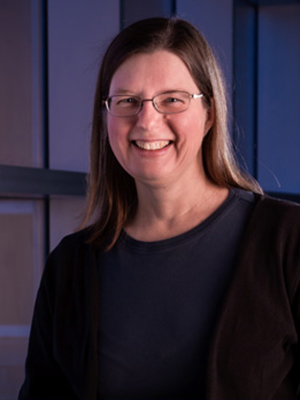 Professor of Physics
Professor of Physics
Sub-Atomic Physics, Physics Education
BDK Science Center 308B
(937) 327-7854
egeorge@wittenberg.edu
Profile
As an undergraduate, Dr. George spent several summers working with a research group at the University of Missouri, using the wave properties of neutrons to investigate questions in quantum physics. This experience motivated her interest in teaching and doing research with undergraduate students. After earning an MS in medical physics and a PhD in experimental nuclear physics and teaching at colleges in New Jersey and Wisconsin, she joined the Wittenberg faculty in 1998.
At Wittenberg, she has designed courses in biomedical physics, nuclear and particle physics, electronics, chaos and fractals, and pattern formation. She has been involved in physics education research, studying how students' use of computers in the physics laboratory affects their learning about momentum and energy. She is active in regional and national physics organizations, has helped organize national conferences on teaching experimental physics, and recently served as the president of the Advanced Laboratory Physics Association.
Her current research is investigating fundamental forces and symmetries of nature by doing experiments on nuclear beta decay and on positronium (an artificial “atom” consisting of an electron and a positron). These experiments involve Wittenberg students in frontline, hands-on research. She has also worked with Wittenberg students on environmental projects such as studying the restoration of local river systems and calculating the university's carbon footprint.
Degrees
- Ph.D. Physics, University of Wisconsin-Madison, 1993
- M.S. Radiology (Medical Physics), University of Colorado Health Sciences Center, 1986
- B.S. Physics, University of Arizona, 1983
Notable accomplishments
- Wittenberg Alumni Association Distinguished Teaching Award, 2019
- CASE Ohio Professor of the Year, 2014
- Finalist, Sigma Xi Graduate Research Award, University of Wisconsin, 1993
New courses developed
- Biomedical Physics
- Patterns in Nature
- Finding Order in Chaos
- Nuclear and Particle Physics
- Electronics
Research interests
- Precision tests of fundamental forces and symmetries
- Physics education
- Physics applied to environmental problems
Selected publications
- “Measurement of the 20F half-life,” M. Hughes et al., Phys. Rev. C 97, 054328 (2018).
- “Measurement of the branching ratio for the beta decay of 14O,” P. A. Voytas et al., Phys. Rev. C 92, 065502 (2015). This article was featured as an “Editor’s Suggestion” in the December 2015 issue of Physical Review C.
- “Measurement of the shape factor for the beta decay of 14O,” E.A. George et al., Phys. Rev. C 90, 065501 (2014).
- “A superconducting beta spectrometer,” L.D. Knutson et al., Rev. Sci. Instrum. 82, 073302 (2011). This article was also selected for the August 1, 2011 issue of the Virtual Journal of Applications of Superconductivity.
- “The Ay problem for p-3He elastic scattering,” M. Viviani et al., Phys. Rev. Lett. 86, 3739 (2001).
- “Observing students' use of computer-based tools during collision experiments,” Elizabeth A. George, Maan J. Broadstock, and Jesús Vázquez-Abad, Proceedings of the 2001 Physics Education Research Conference.
- “Neutron interferometric search for quaternions in quantum mechanics,” H. Kaiser, E.A. George, and S.A. Werner, Phys. Rev. A 29, 2276 (1984).
- “Direct measurement of the longitudinal coherence length of a thermal neutron beam,” H. Kaiser, S.A. Werner, and E.A. George, Phys. Rev. Lett. 50, 560 (1983).
Selected invited conference presentations
- Panelist: “The latest & greatest electronic resources from the AAPT and how to access them on the web”, AAPT summer meeting, Washington DC, July 2018
- “Revitalizing Upper-Level Laboratory Instruction: Opportunities and Initiatives,” APS March meeting, Los Angeles CA, March 2018
- Panelist: “Choosing Apparatus for Advanced Laboratories,” AAPT Winter Meeting, San Diego CA, January 2018
Selected conference presentations by students
- “Determining Scintillator Nonlinearity using the Wide Angle Compton Coincidence Technique,” Anna Beggs, Fall Meeting of the APS Division of Nuclear Physics, Arlington VA, October 2019.
- “Monte Carlo simulations for a carbon-14 beta spectrum measurement,” Xavier Davenport, Fall Meeting of the APS Division of Nuclear Physics, Pittsburgh PA, October 2017.
- “Computational Model of Fluorine-20 Experiment,” Thomas Chuna, Fall Meeting of the APS Division of Nuclear Physics, Santa Fe NM, October 2015.
- “Buck Creek restoration: Two-stage ditch modeling,” Aeron Roach, 2015 International Student Conference on Environment and Sustainability, Shanghai, China, June 2015.
Selected external grants awarded
- Co-investigator for “MRI: Development of a High Sensitivity Instrument to Search for CP Violation in Positronium Decay,” National Science Foundation, funded 2019-2022
- Co-investigator for “Disseminating Instructional Physics Labs - ALPhA's Immersion Workshops for Faculty Development,” National Science Foundation, funded 2017-9
- Co- investigator for “RUI: Precision Weak Interaction Studies in Nuclei,” National Science Foundation, funded 2015-2020
- Co-investigator for “MRI: Acquisition of an All Digital Multiparameter Gamma Spectroscopy System for Research and Research Training in Nuclear Physics,” National Science Foundation, funded 2015-6
Selected professional activities
- Advanced Laboratory Physics Association (President, 2018-2020)
- American Association of Physics Teachers (Southern Ohio Section Executive Committee member)
- Co-chair of organizing committee, 2015 Conference on Physics Laboratory Instruction Beyond the First Year, College Park, MD
- Wrote biomedical application problems for introductory physics textbooks
Recent student research projects supervised
- “Flow modeling of Buck Creek”
- “Wittenberg’s Climate Impact”
- “Wide Angle Compton Coincidence Technique for Determining Scintillator Nonlinearity”
- “Apparatus for Positronium formation”
- “Gamma ray spectroscopy with a silicon photomultiplier and a LYSO crystal”
- “Electron backscattering simulations for beta decay experiments”
- “The beta spectrum of 20F”
- “Modeling the circulatory system”
- “Applications of synchronized chaotic circuits”

